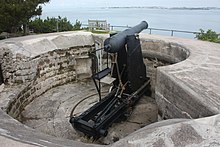





A disappearing gun, a gun mounted on a disappearing carriage, is an obsolete type of artillery which enabled a gun to hide from direct fire and observation. The overwhelming majority of carriage designs enabled the gun to rotate backwards and down behind a parapet, or into a pit protected by a wall, after it was fired; a small number were simply barbette mounts on a retractable platform. Either way, retraction lowered the gun from view and direct fire by the enemy while it was being reloaded. It also made reloading easier, since it lowered the breech to a level just above the loading platform, and shells could be rolled right up to the open breech for loading and ramming. Other benefits over non-disappearing types were a higher rate of repetitive fire and less fatigue for the gun crew.[1]
Some disappearing carriages were complicated mechanisms, protection from aircraft observation and attack was difficult, and almost all restricted the elevation of the gun. With a few exceptions, construction of new disappearing gun installations ceased by 1918. The last new disappearing gun installation was a solo 16-inch gun M1919 at Fort Michie on Great Gull Island, New York, completed in 1923. In the U.S., due to lack of funding for sufficient replacements, the disappearing gun remained the most numerous type of coast defense weapon until replaced by improved weapons in World War II.[2][3]
Although some early designs were intended as field siege guns, over time the design became associated with fixed fortifications, most of which were coastal artillery. A late exception was the use in mountain fortifications in Switzerland, where six 120 mm guns on rail-mounted Saint Chamond disappearing carriages remained at Fort de Dailly until replaced in 1940.
The disappearing gun was usually moved down behind the parapet or into its protective housing by the force of its own recoil, but some also used compressed air[4] while a few were built to be raised by steam.[5]
- ^ "??". Transactions of the American Society of Civil Engineers. 54 (1). American Society of Civil Engineers: 66. 1905.
- ^ Complete list of US forts and batteries at CDSG website
- ^ Berhow, pp. 200-228
- ^ Disappearing Guns Archived 2016-08-07 at the Wayback Machine (from the Royal New Zealand Artillery Old Comrades Association)
- ^ The Defenses of Sandy Hook Archived 2009-06-17 at the Wayback Machine (from a Sandy Hook, Gateway National Recreation Area, U.S. National Park Service information pamphlet. Accessed 2008-02-22.)